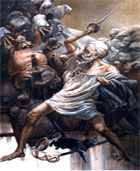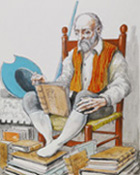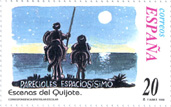IV Centenary Publication of "Don Quixote"
The Novel
"In a village of La Mancha, the name of which I have no desire to call to mind, there lived not long since one of those gentlemen that keep a lance in the lance-rack, an old buckler, a lean hack, and a greyhound for coursing..." thus begins the most treasured gem in Castilian literature, published in the year 1605 by Miguel de Cervantes Saavedra.
A novel that has triumphed worldwide and is perhaps, together with the Bible, the work that has been translated into more languages than any other. Moreover the characters from its pages have come to be veritable archetypes on a universal scale: Don Quixote, the idealist and dreamer; Sancho Panza, the loyal companion, practical and something of a fatalist.
Brief outline

Don Quixote tells the story of a gentleman of rank from La Mancha who, from so much reading of tales of chivalry, goes insane and believes he is a knight-errant.
"...he became so absorbed in his books that he spent his nights from sunset to sunrise, and his days from dawn to dark, poring over them; and what with little sleep and much reading his brains got so dry that he lost his wits."
He leaves his village three times seeking adventures and "to set wrongdoings to rights", confusing reality with fiction and for the most part taking a thrashing. He finally returns home, gets sick, recovers his wits and dies.
Between his first sortie and his ultimate return to the hamlet, a whole series of small incidents are chronicled that our protagonist turns into authentic chivalrous episodes, though not always due to his own lunacy.
"The barber was all this time on his knees at great pains to hide his laughter and not let his beard fall, for had it fallen maybe their fine scheme would have come to nothing..."
Freedom
But what Cervantes advocates, and the reason why Don Quixote has become an immortal novel, besides the exceptional care taken with the language spoken by each of the characters, is his belief in FREEDOM. This topic appears continuously throughout the whole book, prompted by the years of captivity that Cervantes spent in Algiers:
" - Freedom, Sancho, is one of the most precious gifts that heaven has bestowed upon men; no treasures that the earth holds buried or the sea conceals can compare with it; for freedom, as for honour, life may and should be ventured; and on the other hand, captivity is the greatest evil that can fall to the lot of man."
Cervantes
Don Quixote of La Mancha was written in the 17th century by Miguel de Cervantes Saavedra, a Spanish poet, novelist and playwright born in Alcalá de Henares around 1547. He is considered to be the greatest Spanish writer of all time, and one of the best worldwide.
Autobiography

In the prologue to the Exemplary Novels Cervantes describes himself:
"The man you see before you, with aquiline features, chestnut-coloured hair, smooth and unwrinkled brow, bright eyes and curved though well-proportioned nose, silver beard that not twenty years ago was golden, large moustache, small mouth, teeth neither large nor small since he boasts only six of them, and those he has are in poor condition and even worse positions, for not one of them cuts against another; he has medium build, neither tall nor short, a healthy colour in his cheeks, fair rather than dark complexion, slightly stooping, and not very light on his feet. This, then, is a description of the author of "La Galatea" and "Don Quixote of la Mancha" and the man who wrote "Journey to Parnassus", which was modelled on the one by César Caporal Perusino,and other works which have gone astray, perhaps without their owner's name upon them. He is commonly known as Miguel de Cervantes Saavedra. He was for many years a soldier and a prisoner for five and a half after that, during which time he learned to cultivate patience in adversity. He lost his left hand in the naval battle of Lepanto to a blunderbuss shot, and although the injury is ugly he considers it beautiful because he incurred it at the most noble and memorable event that past centuries have seen or future generations can ever hope to witness, fighting beneath the victorious banners of the son of that thunderbolt of war, Charles V of happy memory."
The author of Don Quixote
He had turned 50 years old, and was the author of several works of poetry, plays and novels, when he published "The Ingenious Gentleman Don Quixote of La Mancha". It brought him immediate acclaim, though it did not free him from the financial difficulties that dominated most of his life. Not many years later came the publication of the copy written by Alonso Fernández de Avellaneda, and this spurred Cervantes on to completing the second part of Don Quixote. This was published in 1615 and contains frequent allusions to the "false Quixote".
""...The alcalde of the village came by chance into the inn together with a notary, and Don Quixote laid a petition before him, showing that it was requisite for his rights that Don Alvaro Tarfe, the gentleman there present, should make a declaration before him that he did not know Don Quixote of La Mancha, also there present, and that he was not the one that was in print in a history entitled "Second Part of Don Quixote of La Mancha, by one Avellaneda of Tordesillas."
He died on April 23rd 1616. The day has been declared by the UNESCO to be World Book Day.
Highly regarded piece
"The Ingenious Gentleman Don Quixote of La Mancha" met with instant success. This was borne out by the appearance in Lisbon of two false editions a few weeks after the novel was published. Then, only seven years later it was first translated into English by Thomas Shelton under the title "The History of the Valorous and Wittie Knight-Errant Don Quixote of the Mancha". Numerous translations have since followed, and, together with the Bible, it has become the piece of literature that has been translated into the most languages worldwide.
Far-reaching importance and repercussion

In the year 2002 it was elected the best work of fiction in history, out of a selection of 100 writers from 54 countries organized by the Norwegian Book Club and the Nobel Foundation.
It has been the inspiration for literary works, films, musical compositions, plays, ballets, paintings, postage stamps, comics, etc. the world over.
Furthermore it has given rise to a specific word in the dictionary of the Royal Spanish Academy:
quijote2. m. Man who prefers his ideals to his convenience and steadfastly in defense of causes that he considers just, without achieving his purpose. || 2. A tall, skinny man of serious countenance, whose appearance and character traits put one in mind of Cervantes' heroe.
Fourth Centenary of the publication of the novel
The year 2005 marks the fourth centenary of the first edition of the work. In commemoration of this anniversary, the Spanish Royal Mint has minted a coin set composed of three coins of 8 reales in silver with a face value of 10 Euros, a silver cincuentín with a face value of 50 Euros, and a coin of 8 escudos in gold with a face value of 400 Euros; in addition, a silver coin with a face value of 12 Euros and a commemorative coin of 2.
For additional information please visit the following links:
Miguel de Cervantes Virtual Library: www.cervantesvirtual.com
